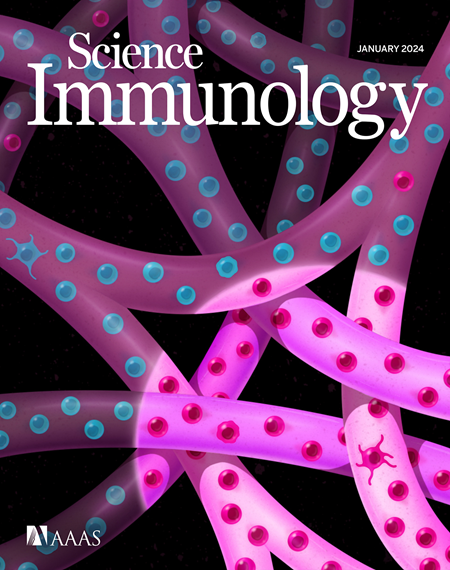MAIT cell heterogeneity across paired human tissues reveals specialization of distinct regulatory and enhanced effector profiles
IF 17.6
1区 医学
Q1 IMMUNOLOGY
引用次数: 0
Abstract
Mucosal-associated invariant T (MAIT) cells are unconventional T cells that recognize microbial riboflavin pathway metabolites presented by evolutionarily conserved MR1 molecules. We explored the human MAIT cell compartment across organ donor–matched blood, barrier, and lymphoid tissues. MAIT cell population size was donor dependent with distinct tissue compartmentalization patterns and adaptations: Intestinal CD103+ resident MAIT cells presented an immunoregulatory CD39highCD27low profile, whereas MAIT cells expressing NCAM1/CD56 dominated in the liver and exhibited enhanced effector capacity with elevated response magnitude and polyfunctionality. Both intestinal CD39high and hepatic CD56+ adaptations accumulated with donor age. CD56+ MAIT cells displayed limited T cell receptor–repertoire breadth, elevated MR1 binding, and a transcriptional profile skewed toward innate activation pathways. Furthermore, CD56 was dynamically up-regulated to a persistent steady-state equilibrium after exposure to antigen or IL-7. In summary, we demonstrate functional heterogeneity and tissue site adaptation in resident MAIT cells across human barrier tissues with distinct regulatory and effector signatures.
配对人体组织中 MAIT 细胞的异质性揭示了独特的调节和增强效应特征。
粘膜相关不变T细胞(MAIT)是一种非常规T细胞,能识别由进化保守的MR1分子呈现的微生物核黄素途径代谢产物。我们研究了器官供体匹配的血液、屏障和淋巴组织中的人类 MAIT 细胞区系。MAIT 细胞群的大小与供体有关,并具有不同的组织分区模式和适应性:肠道CD103+常住MAIT细胞呈现出CD39高CD27低的免疫调节特征,而表达NCAM1/CD56的MAIT细胞在肝脏中占主导地位,并表现出更强的效应能力,具有更高的反应幅度和多功能性。肠道 CD39high 和肝脏 CD56+ 适应性都随着供体年龄的增长而增强。CD56+ MAIT 细胞的 T 细胞受体谱广度有限,MR1 结合率高,转录谱偏向于先天性激活途径。此外,CD56在暴露于抗原或IL-7后会动态上调至持续的稳态平衡。总之,我们证明了人体屏障组织中常驻 MAIT 细胞的功能异质性和组织部位适应性,它们具有不同的调节和效应特征。
本文章由计算机程序翻译,如有差异,请以英文原文为准。
求助全文
约1分钟内获得全文
求助全文
来源期刊

Science Immunology
Immunology and Microbiology-Immunology
CiteScore
32.90
自引率
2.00%
发文量
183
期刊介绍:
Science Immunology is a peer-reviewed journal that publishes original research articles in the field of immunology. The journal encourages the submission of research findings from all areas of immunology, including studies on innate and adaptive immunity, immune cell development and differentiation, immunogenomics, systems immunology, structural immunology, antigen presentation, immunometabolism, and mucosal immunology. Additionally, the journal covers research on immune contributions to health and disease, such as host defense, inflammation, cancer immunology, autoimmunity, allergy, transplantation, and immunodeficiency. Science Immunology maintains the same high-quality standard as other journals in the Science family and aims to facilitate understanding of the immune system by showcasing innovative advances in immunology research from all organisms and model systems, including humans.
 求助内容:
求助内容: 应助结果提醒方式:
应助结果提醒方式:


